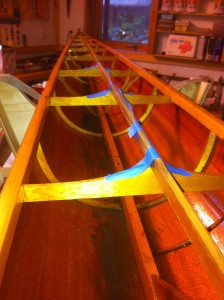January 1, 2016.
Pictured above is a 1965 Phelps shell in my shop for restoration over the winter while the RowSafeUSA website has been undergoing restoration of a different sort. The Phelps is a beautifully built (LOA 25’11”, beam 10.5″, weight 33 lbs with riggers) and restoration has been a matter of repairing damage incurred over the past fifty years. The boat has been stripped and faired, minor cracks epoxied, a section of the hull damaged by an errant heel replaced, a cork liner installed in the cockpit, and a new dacron deck installed. All that remains now are additional coats of varnish before the boat is returned to the water.
The website, of course, has been a different matter. RowSafeUSA generated considerable support for its content and the accuracy of its information, but less support for its attempts to stimulate discussion. All of the comments have been reviewed, criticisms considered, and as a result the coming months should see a sharper focus on rowing safety in the broader context of other scholastic sports. Sports’ concussions have become mainstream news in the past year but the sudden emergence of the issue after decades of neglect serves as a reminded that we often deny risks that we could be mitigating and which should be, or should have been, apparent to us.
As more people of all ages become involved in rowing and competition becomes more intense we should also be paying more attention to the risks that exist. The fact that traumatic injuries are few and deaths rare doesn’t mean that we shouldn’t be keeping track of the accidents and injuries that do occur. As parents, coaches, and administrators we have an obligation to keep track of accidents and injuries so that they can be objectively reviewed, numbers can be evaluated, and patterns that emerge can be addressed.
Does anyone know how many accidents occurred in rowing last year? How many times boats swamped and what were the causes, or how many collisions or near-misses occurred? Does anyone know how many times a scholastic boat was lost in the fog and unaccounted for at the end of practice? Does anyone know how many scholastic rowers were sidelined with back injuries, or whether anyone was hospitalized for hypothermia or traumatic injuries? The fact is that swampings did occur, boats were lost in the fog, rowers were sidelined with injuries and there is no systematic accounting of these accidents and injuries. It is in everyone’s interest to make rowing as safe as it can reasonably be, but without systematic collection of these records we have no way of knowing what can be done to make rowing safer than it is.
Let me put that in the form of a New Year’s resolution: Let’s keep records of injuries and accidents alongside the boathouse log books so that they can be systematically collected (see item 15 in RowSafeUSA’s Basic Standards) and analyzed. It isn’t hard, and it isn’t costly. It’s time to start doing it.

